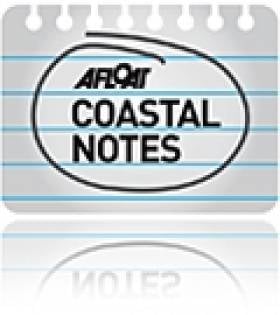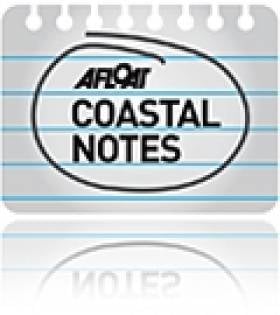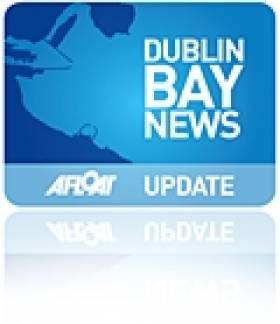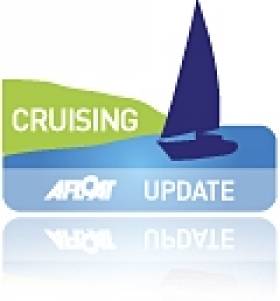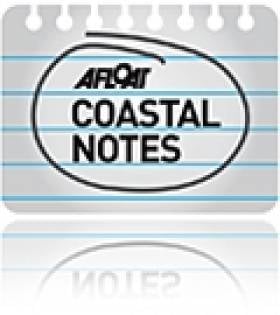Displaying items by tag: Harbour
Baltimore Harbour Landing Pontoon & Gangway to Aid Boating Visitors & Aquatic tourism
#baltimore – First pictures from Baltimore Sea Safari marine company show the West Cork village's smart new central pontoon and gangway being put in place in the inner harbour. The new Baltimore harbour facility will be beneficial as a landing place for visiting boats.
And it's sure to be useful to the Optimist dinghy class when 160 gather at Baltimore Sailing Club for the mid–term school break next week.
More on the sailing and boating wonders of West Cork in WM Nixon's blog here.
Wicklow Aerial Video Captures Garden Coastline & Stunning Sea Views
#wicklow – No surprise that this County Wicklow from the air vid features the Garden County's stunning coastline but Skycam Ireland's crisp footage via drone goes so much further to capture incredible coastal scenery right on the Capital's doorstep.
There is spectacular views of rolling green hills and a weather-beaten rocky coastline. There's castles and towers stationed on every headland, giving you the feeling of flying through a scene from 'Lord of the Rings'.
Nearby Dublin Bay sailors will instantly recognise familiar landmarks including Wicklow Head, its prominent lighthouses and Wicklow harbour itself, the home of the Round Ireland yacht race. The four–minute video includes coastal scenes of Killiney Bay and Bray Head and shots over water along an historically important stretch of Kilcoole beach.
There are many more water-based shots featured too including Wickow's amazing lakes, waterfalls and watch out for the cute seal!
We hope Skycam are planning a 2015 verison, if so Afloat.ie recommends a flight over Greystones Harbour and Marina to capture the country's newest coastal marina facility.
Dún Laoghaire Harbour Company Welcomes Planning Permission for Urban Beach Project
#urbanbeach – Dún Laoghaire Harbour Company (DLHC) has welcomed the award of planning permission for its proposal for a floating swimming pool and urban beach at the historic East Pier of the Harbour. Permission was granted by Dún Laoghaire Rathdown County Council in recent days.
The project has been inspired by the popular Badeschiff facility in Berlin, a floating swimming pool on the River Spree. The plan for Dún Laoghaire Harbour includes a floating swimming pool containing heated and treated seawater, utilising a converted river barge which will be located within the Harbour. The facility will include an Urban Beach alongside the floating structure, on Berth 1 adjacent to the East Pier. Changing and toilet facilities, a café, an administration area, and security features are also planned.
The Harbour Company estimates that urban beach has the potential to attract 140,000 visitors per annum and to generate over €1 million per annum for the local economy.
Dún Laoghaire Harbour Company hopes to be in a position to open the facility for the summer season in 2016.
According to Gerry Dunne, CEO of DLHC: "The granting of planning permission by Dún Laoghaire Rathdown County Council is very welcome, and marks a vital step in realising the full potential of the Harbour as a marine, leisure and tourist destination of international calibre."
"Further to extensive consultation, Dún Laoghaire Harbour Company published a very exciting Masterplan in 2011. The urban beach, coupled with plans for enhanced cruise berthing facilities and the development of a world-class diaspora centre, formed the corner-stone of this plan. The ambitions for the Harbour are very much in-keeping with the Government's National Ports Policy to designate Dún Laoghaire as a harbour focusing on marine leisure, marine tourism, and urban development. Therefore, we are delighted to receive planning permission for the beach allows us to follow through on our mandate."
In recent months, Dún Laoghaire Harbour Company has had great success in marketing the Harbour as a destination for cruise calls. In 2015, it is estimated that Dun Laoghaire will attract c100, 000 cruise passengers and crew. A planning application under the Strategic Infrastructure Development Act for a new cruise berth for 'next generation' cruise ship is expected to be submitted in the coming weeks to An Bord Pleanála
Cape Clear Harbour Works Continue With New Slip & Pier Works
#capeclear – Construction work continues apace at Cape Clear island in West Cork as this latest photo posted via Twitter reveals. As Afloat previously reported in March, the works have involved the construction of a slipway; replacement of the Bull's Nose structure incorporating a storm gate and an extension to the end of Duffy's Pier; excavation, dredging and reclamation works including the construction of an armoured embankment at the seaward side of the new Bull's Nose structure.
A short aerial video of the installation of the massive 950–tonne precast concrete storm gate chamber is below. Scroll down to view.
Minister of Sport Appoints Royal St. George Vice–Commodore to Dun Laoghaire Harbour Company Board
#dlhc – Royal St. George Yacht Club vice–commodore Justin McKenna has been appointed to the Board of Dun Laoghaire Harbour Company. Well known yachtsman McKenna is a former chairman of the Dun Laoghaire Comnied Yacht Clubs and the current vice–chairman of the country's biggest yacht club, the Royal St. George that occupies a key location within the harbour on Dun Laoghaire's waterfront. He joins two new Board members appointed to the Board by the Minister for Transport, Tourism and Sport, Leo Varadkar TD and come into effect immediately.
The appointments are:
· Mark Finan who is a barrister-at-law with particular expertise in regulatory compliance, European and international law. He lives in Monkstown, Co Dublin.
· Justin McKenna who is a solicitor at the Dún Laoghaire-based solicitor practice, Partners at Law.
· James Jordan is a retired SIPTU trade union official and continues to be a community activist in the Dún Laoghaire area. He lives in Glenageary, Co Dublin.
The Board of Dún Laoghaire Harbour Company now comprises eight members, which is the maximum membership it can have.Speaking on the appointments, Chairperson of Dún Laoghaire Harbour Company, Eithne Scott Lennon said: "The appointment of three additional members to the Board of the Harbour Company by the Minister for Transport, Tourism and Sport, Leo Varadkar, gives us greater strength as we move into one of the most active development phases in the Harbour's history. "Following on from the Harbour Company's development plan, we are now embarking on the execution of some major infrastructural projects which will – I believe – position Dún Laoghaire as the primary leisure port facility in Ireland."
Plans include the delivery of an International Diaspora Centre on the historic Carlisle Pier, a deep cruise berth facility and a new mixed use housing and retail development. A number of initiatives to add to the leisure offerings at the Harbour have already been instigated, including the Urban Beach project, the Shackleton Exhibition and the new drive-in movie initiative which will commence later this month.
A key area of development for the Harbour Company has been the increase in cruise-calls to Dún Laoghaire in recent years, and we expect to deliver 100,000 leisure visitors and crew to Dún Laoghaire and its hinterland in 2015
Although a town marina for Schull gets ever closer for the moment boaters make do with a quay and a 40-foot long pontoon in Schull Harbour, primarily used by small boats. It is a facility that makes embarkation and disembarkation easier.
Dun Laoghaire Harbour Master Resigns After a Year
#harbourmaster – Dun Laoghaire Harbour master Frank Allen has resigned just a year after taking over the state job. Dun Laoghaire harbour Company (DLHC) confirmed Captain Allen left the post yesterday according to a report by Barry O'Halloran in this morning's Irish Times.
Part of Captain Allen's brief was to play a role in attracting Cruise liners to the south county Dublin harbour. A new disembarkation point has been completed in the Coal harbour and some new ships docked in Dun Laoghaire this Summer including Quest, an arctic expedition ship.
DLHC hopes to create 1000 new jobs according to a Harbour Masterplan launched a year ago.
Former Harbour master Simon Coate has taken over as acting harbour master.
Dun Laoghaire Harbour hosts this week's international Four Star Pizza ISAF Youth World Championships, the biggest sailing event of its kind to be held in Ireland starting this Friday.
The Irish Times has more on the story here.
#trailersailer – Ireland's coastline is one of the world's finest cruising grounds. Yet there are long lengths of the coast that rarely see a visiting cruiser. It is not that the area is inhospitable, although the weather can be challenging. Safe anchorages and sheltered harbours are numerous, the welcome on shore is legendary. The plain fact is that, for many of us the west coast of Ireland is very much the Far West.
A circumnavigation of the island is over 700 miles, roughly the same distance as the Fastnet Race, longer than the Sydney-Hobart, or the Newport-Bermuda. For the East Coast cruising sailor with a fortnight to spare Wales, Cornwall or Scotland are nearer, and, in the prevailing westerlies, easier to reach. Cork sailors can explore West Cork or South Kerry, but a trip to Galway is a serious voyage, with a long stretch of coast offering little or no shelter.
Any plan to develop cruising from Cork to Donegal must take account of the distances involved. One solution would be to develop marinas and encourage boat owners to keep their boat there for all or part of the year. However, maintaining a boat that is several hours drive from home is never easy. Those who are fortunate to keep boats in France, Portugal or elsewhere can depend on a well developed network of professionals, with workshops in the harbour area, to carry out necessary work. Unfortunately, marinas in Ireland are conceived more as a pretext to develop shore-side housing, rather than as essential industrial infrastructure. Boatyards and luxury apartments do not make good neighbours!
Basing the boat on the west coast for a month or two is no less problematic. Finding a window of opportunity, and the crew, for the delivery trip there and back, is never easy. A 300 mile cruise is, for many, already a summer holiday in itself! Furthermore, sailors can be reluctant to abandon the short but intense racing season, especially on the East Coast.
There is an alternative: the trailer-sailer, or, as well known nautical author Sam Llewelyn prefers – the "Minimum Boat". For an owner wishing to explore the nooks and crannies of the Irish coast such boats have huge advantages. The ability to tow a boat to a suitable area greatly extends the range of possible cruising grounds. The flexibility of such a mobile boat means that plans can be changed easily. You may have planned a weekend trip to the Aran Islands, but if the forecast is for squalls, rain and a huge swell it is no great problem to divert to Lough Derg, or even to "go foreign" and explore Lough Erne. How often is it set to rain in Kerry while Donegal basks in sunshine (or vice versa). Until you choose which exit to take off the motorway, the "Minimum Boat" owner is not committed to any one destination.
In addition, a ferry trip to Cherbourg or Roscoff opens up the whole of Europe. Personally I quite fancy exploring the Venice Lagoon or the Skerries of the northern Baltic.
In choosing a "Minimum Boat" compromises have to be made, between the boats nautical capacities, convenience when rigging, launching and recovering and the trappings of modern comforts. Many commonly used boats are no longer than 21-22 foot, and no more than 2 tons. Increasingly water ballast is used, reducing the towing weight, making it possible to tow and launch somewhat larger boats.
Obviously, a boat this size will not have standing headroom throughout. Farewell the power shower, the microwave and the master cabin. However, there is great pleasure in rediscovering the little luxuries – making that first tea or coffee whilst still in your sleeping bag, stepping ashore from the bow of the boat on a sheltered beach or settling down for the night in an anchorage known only to those that go to sea in kayaks or RIBs. Not forgetting that keeping the boat in the garden is a great convenience when maintenance is required.
Cruising on boats this size is more about exploring the coast and the islands, rather than passage making. In fact the whole point of the trailer-sailer is that long passages are made by road. The most difficult moments of any holiday will be launching and recovery. Many cars can cope with towing a fairly substantial boat. However, slipways are often narrow and steep. Alexander Nimmo and his fellow engineers of the 19th Century singularly failed to take account of the constraints of launching a small yacht from a road trailer when engaged in building so many harbours, piers and slips that are still the backbone of our nautical infrastructure. If a Minimum Boater has to rely on launching only at well-equipped boatyards or clubs then the range of accessible cruising areas is limited.
A major contribution to the development of trailer sailing could be made at little cost:
⁃ by publishing a comprehensive list of slipways, including details such as the angle of the slip (preferably between 7° and 12°), launching conditions and information on safe parking;
⁃ identifying a local tractor owner who would, for a small charge, tow the trailer down the slip. Ideally, they would also be able to offer safe parking for for car and trailer. Trailer-sailors would be happy to pay for such a service. Obviously, there will be considerations of liability and insurance, but in a period when small farmers, building contractors and other small businesses are facing difficulties, launching and recovering could provide a small but useful revenue stream.
To conclude by an (apocryphal) example:
Sitting in the bar of a well-known yacht club club in Greater Dublin two boat owners are discussing the possibility of viewing from the comfort of their own cockpit the in-port race in Galway Bay when the VOR fleet is in town. One owns a well-found 35 ft yacht that competes in local races. His owner reckons that in order to be sure of getting to Galway in time, and get the boat back, he will take a fortnight's holiday. He already organising a delivery crew, one for each trip, there and back, with the family driving down for the weekend. It is proving difficult to find a berth in Galway and he may have to anchor off somewhere.
His friend has a French-built 21 foot trailer-sailer that has proved competitive in club racing, and did well when he towed the boat to the UK to compete in Cowes Week. His plan is to lift out on Thursday evening after racing and drive down early Friday morning. He intends to launch in Kinvara, having checked the slip on Google Earth, and sail across to Galway. When he called the organisers they told him they would have no problem finding a berth for such a tiny yacht! The in-port race is on Saturday. The plan is to party in Galway on Saturday and sail back to Kinvara on Sunday. With HW just after 2130 there will be no problem getting back to Dublin sometime (possibly late) on Sunday night.
Small is beautiful. More to the point a small trailer friendly yacht is the passport to spending more time in some of the world's most spectacular seascapes – Magheramore
€39.5m Pier Development Opens in Castletownbere
#CASTLETOWNBERE –The Minister for Agriculture, Food and the Marine, Simon Coveney TD officially opened the major new €39.5 million Dinish Wharf Development on Dinish Island at Castletownbere Fishery Harbour Centre and also launched the community led development strategy - 'Castletownbere - An Economic Survey to Determine the Level of Seafood Activity and Establish its Economic Importance for the Region' in Castletownbere today, the 30th April.
Castletownbere Fishery Harbour Centre is one of Ireland's major fishing ports and is Ireland's largest whitefish port. Proximity to rich fishing grounds makes Castletownbere an attractive fish landing location for Irish and foreign vessels. The major pier development on Dinish Island which commenced in 2005 as part of a multi stage project now provides world class infrastructure to grow the marine industries in Castletownbere to new levels. The project is a major infrastructural development that included the dredging of the approach channel, inner harbour and berthing quay at Dinish Island, the construction of a 215m quay and associated infrastructure. The harbour can now accommodate more modern and larger vessels in our fleet and visiting fleets. The development will address congestion in the harbour and presents possibilities for other large fishing vessels to berth at Dinish Island increasing the supply of fish for processing or export and generating greater economic activity. In addition, cruise vessels, large commercial or exploration vessels will also now be able to land into and operate out of Castletownbere.
The report - 'Castletownbere - An Economic Survey to Determine the Level of Seafood Activity and Establish its Economic Importance for the Region' which was facilitated by BIM is the result of a collaborative action by local stakeholders.
The report details qualitative and quantative information on the value that fishing contributes to the town directly and indirectly through ancillary services. Fishing has helped to sustain and develop the local economy. The report identifies new opportunities for the area.
Minister Coveney said; "The new Dinish Wharf Development at Castletownbere Fishery Harbour Centre is an impressive piece of infrastructure. It provides a springboard to grow the fishing, aquaculture and associated industries to new heights and opens the door to the opportunities identified in the report being launched today. I would like to acknowledge the contribution of everyone associated with the construction of this facility, which was lead by my Department. I would also like to congratulate and recognise the hard work that has gone into the compilation of this very detailed report on Castletownbere. As Ireland's largest whitefish port, we are all aware of the integral part the town plays in our fishing industry but it is inspiring to see that local community representatives are now looking to further develop ways to grow the fishing and aquaculture output in the area with a view to generating increased revenue and employment".
Minister Coveney continued "I am very impressed by the initiative and hard work of the local community and stakeholders who have prepared a clear and forward thinking report on the future opportunities to grow employment and economic activity in Castletownbere. I would like to, in particular, thank Eibhlin O'Sullivan (Irish South and West Fishermen's Producer Organisation (IS&WFPO) and Frank Fleming (key actor in the local seafood sector) for their work in bringing together this important work. I would also like to thank Michael Keatinge of BIM for his contribution to the report. This report can now be used as a strategy to drive the seafood sector in Castletownbere forward and deliver much needed job creation and economic activity in the south west based not just on seafood but also on the other economic activities which have been identified in the report as offering potential. The major investment in the harbour can now be the launch pad for delivering on the potential identified in the Report."
Finally Minister Coveney said "Adding value to fish landed in Castletownbere is key to the economic future of the area. For every €1 million of fish landed, a further €2.12m is created by the processing and ancillary sectors. If we can process more Irish and foreign landings, the area will benefit substantially and we are currently working through BIM and the industry to achieve this."
A number of key actions are outlined in the report including:
Improved co-operation in the catching sector
New gear adaptations and techniques
Tuna processing
Surimi processing of boarfish as well as other human consumption options
Frozen prawns at sea brand
Greater differentiation of product in the market place
Explore the potential for adding value from foreign landings
Increase aquaculture development and support including processing.
The report proposes that a local stakeholder group is tasked to implement the actions set out in the report.
Castletownbere is one of six Fishery Harbour Centres that is owned, managed and Developed by the Department of Agriculture, Food and the Marine (others are located at Dunmore East, Howth, Killybegs, Ros an Mhíl and Dingle). The Castletownbere Fishery Harbour Centre Development was initiated following the introduction of more modern and lager fishing vessels carrying greater draft (up to 6 metres) and to ease congestion within the harbour. The development consists of the construction of a new 215 metre quay, a dredged berthing basin and a dredged approach channel.
- Dredging
Due to the historic use of antifouling paints on boats significant concentrations of contaminated sediments were found within the harbour. Specialist dredging techniques, including seabed profiling and use of an eco-dredging bucket were used to bring dredge material ashore. The silt was then stabilised using cement bentonite prior to shipping to a licensed disposal site in Germany.
The remaining uncontaminated dredging material was, where suitable, used to reclaim a substantial area of foreshore. A quantity of material (silt) was disposed at sea.
The deepened and widened approach and manoeuvring channels will allow greater access for deep sea and inshore fishing vessels. Two new navigation piles were constructed marking the approach channel further improving navigational safety within the harbour.
- New Dinish Wharf
The construction of the new Dinish Wharf comprised of two separate elements. The first was a new mass concrete wall supporting a reinforced concrete deck. The completion of this new quay allowed the fishing fleet to move from the existing old Dinish Wharf, thereby keeping the harbour fully operational during construction.
The second stage was replacement of the old Dinish Wharf Pier, an open timber fender construction, which was structurally inadequate. The replacement structure is a suspended reinforced concrete slab supported on steel cased reinforce concrete piles, with a concrete face.
The completed Dinish Wharf development provides a total berthing length of 266 metres (including end return walls); and a 0.7 hectare deck surface working area. The total cost of developing the new quay, dredging berthing basin and dredging approach channel amounted to €39.5 million
Bord Iascaigh Mhara (BIM), the Irish Sea Fisheries Board is the Irish State agency with responsibility for developing the Irish Sea Fishing and Aquaculture industries. BIM provides commercially relevant and innovative services to the Irish seafood industry that drive growth opportunities, add value, enhance competitiveness and create jobs in a sustainable, natural resource based industry for the benefit of coastal communities. www.bim.ie
- Castletownbere is the primary urban economic and social centre on the Beara Peninsula in South West Ireland. The harbour is one of the largest natural harbours in the world and is formed by Dinish Island to the south (hosting most of the fisheries infrastructure and processing activity) and the town of Castletownbere to the north.
- The town is set in a dramatic and largely unspoilt landscape that is an important asset in the development of secondary, tourist-based, economic activity.
- Castletownbere remains the largest whitefish port in Ireland, with vessels from Spain, Scotland and France making significant landings of whitefish to the port alongside the local fleet.
- The total landed value of fish was €50.4 million in 2010, with around 11,000 tonnes with a value of €23 million landed by Irish vessels targeting pelagic species, monkfish, other whitefish and tuna and 7,500 tonnes with a value of €27 million from foreign vessels targeting monkfish, hake and megrim. There are also significant landings of shellfish (Nephrops, crab and lobster) by the Irish inshore fleet.
The group that produced the report 'Castletownbere - An Economic Survey to Determine the Level of Seafood Activity and Establish its Economic Importance for the Region' was chaired by Eibhlin O'Sullivan (Irish South and West Fishermen's Producer Organisation (IS&WFPO) with the assistance of Frank Fleming (consultant to the IS&WFPO), and co-ordinated by Rod Cappell (Poseidon Aquatic Resource Management Ltd).
The report details how the fish catching and processing sectors in Castletownbere account for over half (54%) of the town's economic activity (the total economic activity for the town is an estimated €146 million). With the inclusion of aquaculture and ancillary sectors, this rises to 86% fisheries-related turnover with the induced spend by employees of these sectors making a substantial contribution to the service and retail sector of the town. Local companies supply oil to the local fleet, foreign fleet and also to vessels based outside of Castletownbere. The total value of the ancillary sector, based on local fleet sales, is estimated to be €19 million (17% of total turnover).
The population of Castletownbere is estimated to be between 900 and 1,000. In terms of employment, 660 jobs representing 81% of the employment in Castletownbere, are related to fishing. This remarkably high level of dependency has been sustained in the area throughout the year as fish is landed from a wide range of fisheries.
Easterly Winds Cause Damage to Yachts in Bray Harbour
#BRAY – We reported on storm damage in Skerries last week when the Irish Sea Champion yacht Raging Bull broke her moorings and it looks like the north-easterlies have caused similar problems further down the East coast at Bray Harbour in County Wicklow. The youtube video posted by 'dreambmx1' shows a yacht breaking free of moorings in Bray harbour last week due to to the extreme conditions. It is understood six boats have been lifted out in Bray over the past few days with boats showing varying degrees of damage. Some boats remain afloat according to the Bray Sailing Club webcam.




























